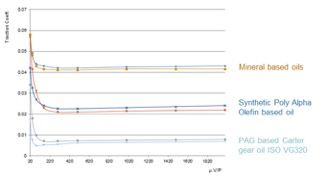20/09/2019 News
Selection of synthetic vs minerals oils in fixed plant applications

Illustration of a symetro gear system (Image reference: https://video.flsmidth.com/maag-symetro-gear-unit-for-ball)
The question is by no means a one size fits all solution. Synthetic lubricants are designed for specific applications and are generally more resistant to oxidative processes.
Therefore, synthetic lubricants will usually last longer than mineral hydrocarbons, providing savings through significant reduction in energy consumption.
On the other hand, synthetic lubricants are also more costly than mineral lubricants.
However, this is often negated by economic benefits with the extended oil drain intervals (ODI) achieved with synthetic lubricants and by the energy efficiency gains received, particularly with Polyalkylene Glycol (PAG) synthetic lubricants.
Part of Total Lubricant’s continuous improvement process (CIP) is to identify opportunities that add real value to the customer.
It is a process where the customer and Total work collaboratively to identify and implement targeted actions. This includes applications of synthetic lubricants when warranted over mineral products in relevant applications.
Value generated is determined by comparing baseline set by current product against savings generated upon successful implementation of the project.
Among other criteria, baseline data would include:
- Current oil drain interval, and
- Current average hourly energy consumption
Input by Total and the customer into a Total Cost of Ownership (TCO) tool will provide data for identifying respective lubricant performance levels and its related cost to determine the best outcome for the customer.
Information provided herewith demonstrates a scenario involving a large industrial gearbox operating in the cement industry. In this case the plant had two identical mills.

Illustration of a symetro gear system (Image reference: https://video.flsmidth.com/maag-symetro-gear-unit-for-ball)
Baseline data was determined before one of the mill gearboxes was changed to a Total PAG synthetic lubricant, namely CARTER SY 320.
Principally, the lower the friction coefficient of the lubricant, the lower the internal resistance of the oil and consequently the improved energy efficiency.
This can be observed in the graph below which shows the reduced internal friction co-efficient of a typical mineral oil over that of a synthetic PAO and again over a synthetic PAG.

Graphical comparison of friction coefficient for different oil types. The lower the friction coefficient, the better it is for energy efficiency.
The synthetic PAG offers the least internal resistance and hence will provide greater energy savings when utilised.
The result of the trial at the mill revealed a two kWh per ton drop in energy usage for the mill gearbox utilising the PAG lubricant in comparison to the prior mineral based oil.
This resulted in actualised savings of over US$90,000 ($132,531) per year in electricity costs.
However, it must be noted that the adoption of the most cost-effective solution must be considered along with other variables.
For example, if consistent contamination of a compartment that utilises a synthetic lubricant exists, additional oil drains will be required, hence resulting in a higher lubricant expense.
The overall energy savings achieved will depend on the severity of the contamination as well as the number of subsequent oil drains needed to reduce equipment wear as a result of this contamination.
Whether synthetic lubricants can be applied instead of mineral based products should always be assessed based on situational factors specific to each customer so that the most beneficial solution can be realised.
Total achieves this with you through the continuous improvement process, which also focuses on lubrication quality and environmental protection.
For further information, please contact the nearest Total Lubricants affiliate, or visit http://www.miningsolutions.total.com/.

